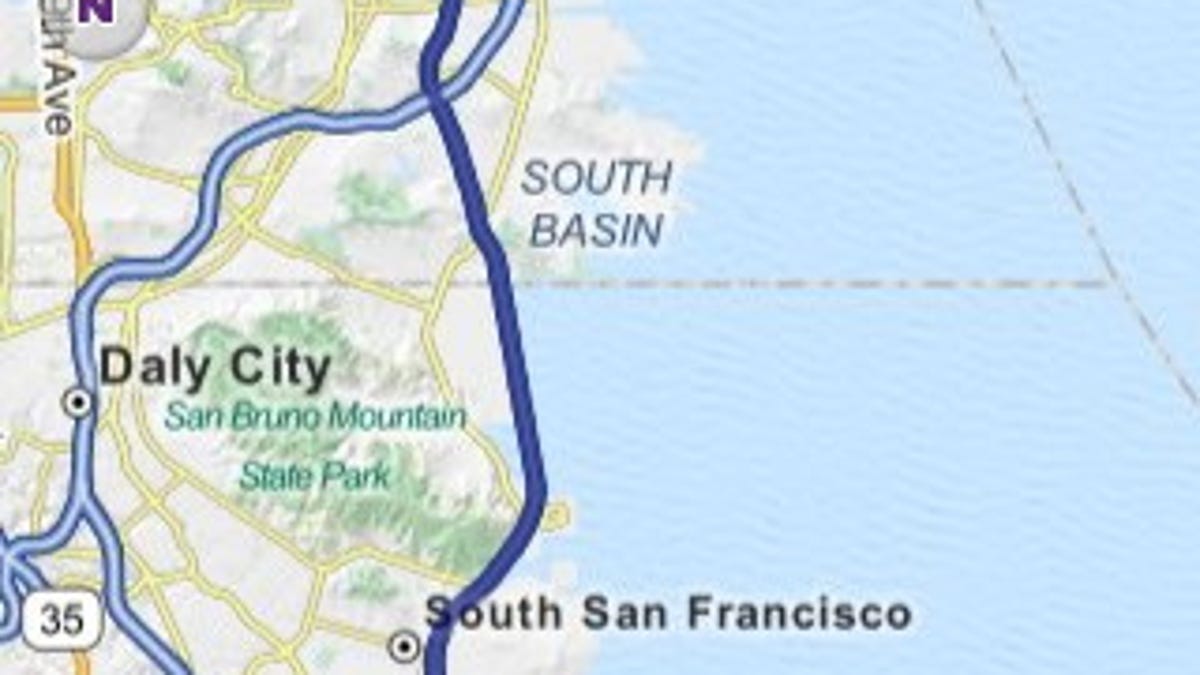MapQuest gives iPhone users free navigation
The MapQuest app for iPhone may be short on many navigation features, but it does offer free voice prompts for route guidance.

In the online maps space, Google may draw more attention, but MapQuest, online years earlier, has continued to improve its service. And among iPhone apps, MapQuest can boast a crucial feature over Google Maps: free turn-by-turn navigation with voice prompts.
MapQuest's history as a mapping company shows up in the app's interface. Unlike navigation-focused apps, the MapQuest app does little to help users look up destinations. At the top of the map the main screen shows a free-form search box where users can enter an address or business name. There are no buttons for previous or favorite destinations, and no real points-of-interest database.
Its one nod toward traditional navigation is a menu bar at the bottom of the screen with icons for gas stations, banks, restaurants, and other categories. Touching one of these menu items lights up corresponding icons on the map, and any one of these can be set as a destination. As one very useful additional feature, the gas station listing includes per-gallon fuel prices, making it easy to find the cheapest nearby gas.
The free-form search is nice in some ways, but can be frustrating. It did a good job when I entered a partial address, or used "SF" instead of spelling out "San Francisco." For less specific searches, I found it best to have the city or region where I wanted to look showing on the map screen. For example, when it was showing downtown San Francisco, I entered "shoreline," thinking it would show Shoreline Amphitheatre, a venue south of my location. Instead, it jumped to a town named Shoreline in Washington. When I entered "Shoreline Amphitheatre," and even intentionally misspelled it, MapQuest showed the right destination.
That search box also works as a partial substitute for a previous-destinations list. When I entered a letter, it immediately brought up a list of prior searches that started with that letter.
Once I selected a destination, MapQuest took a moment to calculate a route, after which I could push a button to start voice navigation. The voice prompts, broadcast in a harsh robotic female voice, were very useful, and even enunciated full street names. A bigger surprise was that the voice prompts also said the name of the business to which I was driving.
Although the voice prompts were perfectly adequate for navigation, the interface also shows turn directions. I could have the route displayed on the map, or switch to a list of turns on the route. The turn direction graphics are on the small side, and the app does not show lane guidance, making it inferior to dedicated navigation apps.
MapQuest automatically recalculated when I got off of its suggested route, but became confused when I was on an elevated freeway, suddenly calculating a route as if I was on the street below. The iPhone's GPS might be partly to blame for that error, but the app should have made the assumption that I was most likely still on the freeway, since there had been no exits for the road below.
And while the app shows traffic information, it didn't seem to take bad traffic into account when calculating a route. When I programmed in destinations beyond some slow areas of freeway traffic, it calculated a route into those traffic jams.
The MapQuest app relies on an active data connection to work, so will not load new maps in areas without cell towers, and it is not able to cache maps. Its standard maps load quickly, but only show in 2D mode. Zooming into a city also shows building outlines. The app also has maps based on satellite imagery, but these load much more slowly than the graphical maps and add a lot of visual confusion to an already small screen.
Probably the best part of the MapQuest app is that it is completely free. Where other apps make features such as traffic or voice prompts paid options, there is no charge at all for MapQuest. However, it does show small ad banners at the top of maps, which can be annoying.

